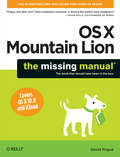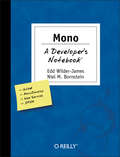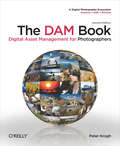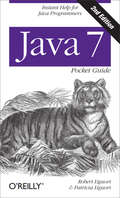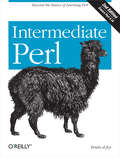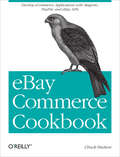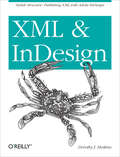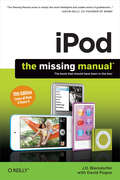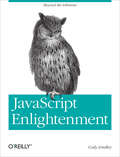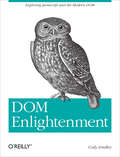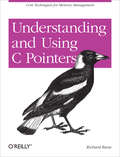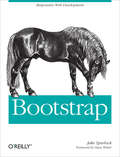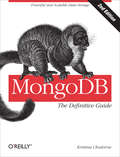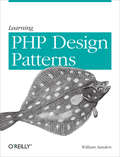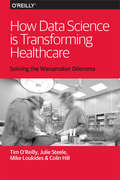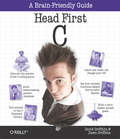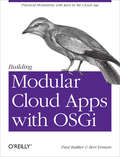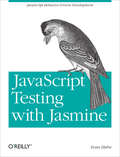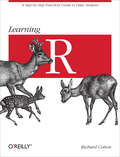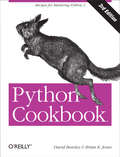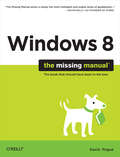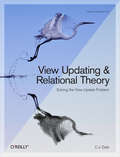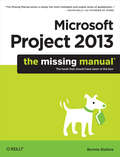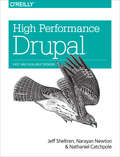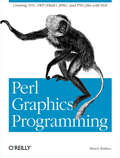- Table View
- List View
OS X Mountain Lion: The Missing Manual
by David PogueWhat do you get when you cross a Mac with an iPad? OS X 10.8 Mountain Lion. Its 200 new features include iPaddish goodies like dictation, Notification Center, and Reminders--but not a single page of instructions. Fortunately, David Pogue is back, with the expertise and humor that have made this the #1 bestselling Mac book for over 10 years straight. Big-ticket changes. Twitter and Facebook intgration. Air-Play TV mirroring. Power Nap. Game Center. Documents in the Cloud. iMessages. Gatekeeper. If Apple wrote it, this book covers it. Mountain Lion Watch. This book demystifies the hundreds of smaller enhancements, too, in all 50 programs that come with the Mac: Safari, Mail, Messages, Preview... Shortcuts. This must be the tippiest, trickiest Mac book ever written. Undocumented surprises await on every page. Power users. Security, accounts, networking, build-your own Services, file sharing with Windows--this one witty, expert guide makes it all crystal clear. There's something new on practically every page of this new edition, and David Pogue brings his celebrated wit and expertise to every one of them. Apple's brought a new cat to town, and Mac OS X Mountain Lion: The Missing Manual is the best way to tame it.
Mono: A Developer's Notebook (Developer's Notebook)
by Edd Dumbill Niel M. BornsteinThe Mono Project is the much talked-about open source initiative to create a Unix implementation of Microsoft's .NET Development Framework. Its purpose is to allow Unix developers to build and deploy cross-platform .NET applications. The project has also sparked interest in developing components, libraries and frameworks with C#, the programming language of .NET. The controversy? Some say Mono will become the preferred platform for Linux development, empowering Linux/Unix developers. Others say it will allow Microsoft to embrace, extend, and extinguish Linux. The controversy rages on, but--like many developers--maybe you've had enough talk and want to see what Mono is really all about. There's one way to find out: roll up your sleeves, get to work, and see what you Mono can do. How do you start? You can research Mono at length. You can play around with it, hoping to figure things out for yourself. Or, you can get straight to work with Mono: A Developer's Notebook --a hands-on guide and your trusty lab partner as you explore Mono 1.0. Light on theory and long on practical application, Mono: A Developer's Notebook bypasses the talk and theory, and jumps right into Mono 1.0. Diving quickly into a rapid tour of Mono, you'll work through nearly fifty mini-projects that will introduce you to the most important and compelling aspects of the 1.0 release. Using the task-oriented format of this new series, you'll learn how to acquire, install, and run Mono on Linux, Windows, or Mac OS X. You'll work with the various Mono components: Gtk#, the Common Language Runtime, the class libraries (both .NET and Mono-provided class libraries), IKVM and the Mono C# compiler. No other resource will take you so deeply into Mono so quickly or show you as effectively what Mono is capable of. The new Developer's Notebooks series from O'Reilly covers important new tools for software developers. Emphasizing example over explanation and practice over theory, they focus on learning by doing--you'll get the goods straight from the masters, in an informal and code-intensive style that suits developers. If you've been curious about Mono, but haven't known where to start, this no-fluff, lab-style guide is the solution.
The DAM Book: Digital Asset Management for Photographers (O'reilly Ser.)
by Peter KroghOne of the main concerns for digital photographers today is asset management: how to file, find, protect, and re-use their photos. The best solutions can be found in The DAM Book, our bestselling guide to managing digital images efficiently and effectively. Anyone who shoots, scans, or stores digital photographs is practicing digital asset management (DAM), but few people do it in a way that makes sense. In this second edition, photographer Peter Krogh -- the leading expert on DAM -- provides new tools and techniques to help professionals, amateurs, and students: Understand the image file lifecycle: from shooting to editing, output, and permanent storage Learn new ways to use metadata and key words to track photo files Create a digital archive and name files clearly Determine a strategy for backing up and validating image data Learn a catalog workflow strategy, using Adobe Bridge, Camera Raw, Adobe Lightroom, Microsoft Expression Media, and Photoshop CS4 together Migrate images from one file format to another, from one storage medium to another, and from film to digital Learn how to copyright images To identify and protect your images in the marketplace, having a solid asset management system is essential. The DAM Book offers the best approach.
Java 7 Pocket Guide: Instant Help for Java Programmers
by Patricia Liguori Robert LiguoriWhen you need quick answers for developing or debugging Java programs, this pocket guide provides a handy reference to the standard features of the Java programming language and its platform. You’ll find helpful programming examples, tables, figures, and lists, as well as supplemental information about topics including the Java Scripting API, third-party tools, and the basics of the Unified Modeling Language (UML).Updated for new features through Java SE 7, this little book is an ideal companion, whether you’re in the office, in the lab, or on the road.Quickly find Java language details, such as naming conventions, fundamental types, and object-oriented programming elementsGet details on the Java SE 7 platform, including development basics, memory management, concurrency, and genericsBrowse through basic information on NIO 2.0, the G1 Garbage Collector, and Project Coin (JSR-334) featuresGet supplemental references to development, CM, and test tools; libraries; IDEs; and Java-related scripting languagesFind information to help you prepare for the Oracle Certified Associate Java SE 7 Programmer I exam
Intermediate Perl: Beyond The Basics of Learning Perl (O'reilly Ser.)
by Randal L. Schwartz Tom Phoenix Brian D Foy<p>Get a clear roadmap for improving your skills with <i>Intermediate Perl</i>, and gain working knowledge of Perl's objects, references, and modules—ingredients that make the language so versatile and effective. Written by the authors of the bestselling Llama book, <i>Learning Perl</i>, and updated for Perl 5.14, this book offers a gentle but thorough introduction to intermediate programming in Perl.</p>
eBay Commerce Cookbook: Using eBay APIs: PayPal, Magento and More
by Chuck Hudson"<p>Take advantage of mobile commerce to generate more demand, traffic, and sales for your products and services. This unique cookbook provides a collection of practical recipes you can put to use in every step of the mobile customer lifecycle. You’ll learn how to add features and functionality through a wide set of eBay APIs—including Magento, Milo, eBay, PayPal, RedLaser, Hunch, and ql.io.</p>
XML and InDesign: Stylish Structure: Publishing XML with Adobe InDesign
by Dorothy J. HoskinsFrom Adobe InDesign CS2 to InDesign CS5, the ability to work with XML content has been built into every version of InDesign. Some of the useful applications are importing database content into InDesign to create catalog pages, exporting XML that will be useful for subsequent publishing processes, and building chunks of content that can be reused in multiple publications. New coverage includes Export in XML order for EPUB (CS5.5 and later) and some new code examples for that process, perhaps some sample GREP to map content to XML, and strategies and settings for the export to EPUB.
iPod: The Missing Manual, Eleventh Edition
by J. D. Biersdorfer<p>Apple’s iPods continue to set the bar for media players, with bold new features like the Touch’s supersized screen and Siri voice control. But iPods still lack a guide to all their features. That’s where this full-color book comes in. It shows you how to play music, movies, and slideshows; shoot photos and videos; and navigate Apple's redesigned iTunes media-management program.</p>
JavaScript Enlightenment: From Library User to JavaScript Developer
by Cody Lindley<p>This short and digestible summary of JavaScript 1.5 (ECMA-262, Edition 3 specification) focuses on the nature of objects in JavaScript, giving you an accurate JavaScript worldview through an examination of native JavaScript objects and supporting nuances. If you’re a designer or developer who has only used JavaScript under the mantle of libraries—such as jQuery and Prototype—the material in this book will help transform you from a JavaScript library user into a JavaScript developer.</p>
DOM Enlightenment: Exploring JavaScript and the Modern DOM
by Cody LindleyWith DOM Enlightenment, you'll learn how to manipulate HTML more efficiently by scripting the Document Object Model (DOM) without a DOM library. Using code examples in cookbook style, author Cody Lindley (jQuery Cookbook) walks you through modern DOM concepts to demonstrate how various node objects work. Over the past decade, developers have buried the DOM under frameworks that simplify its use. This book brings these tools back into focus, using concepts and code native to modern browsers. You'll understand the role jQuery plays in DOM scripting, and learn how to use the DOM directly in applications for mobile devices and specific browsers that require low overhead. Understand JavaScript node objects and their relationship to the DOM Learn the properties and methods of document, element, text, and DocumentFragment objects Delve into element node selecting, geometry, and inline styles Add CSS style sheets to an HTML document and use CSSStyleRule objects Set up DOM events by using different code patterns Learn the author's vision for dom.js, a jQuery-inspired DOM Library for modern browsers
Understanding and Using C Pointers: Core Techniques for Memory Management
by Richard ReeseImprove your programming through a solid understanding of C pointers and memory management. With this practical book, you'll learn how pointers provide the mechanism to dynamically manipulate memory, enhance support for data structures, and enable access to hardware. Author Richard Reese shows you how to use pointers with arrays, strings, structures, and functions, using memory models throughout the book. Difficult to master, pointers provide C with much flexibility and power--yet few resources are dedicated to this data type. This comprehensive book has the information you need, whether you're a beginner or an experienced C or C++ programmer or developer. Get an introduction to pointers, including the declaration of different pointer types Learn about dynamic memory allocation, de-allocation, and alternative memory management techniques Use techniques for passing or returning data to and from functions Understand the fundamental aspects of arrays as they relate to pointers Explore the basics of strings and how pointers are used to support them Examine why pointers can be the source of security problems, such as buffer overflow Learn several pointer techniques, such as the use of opaque pointers, bounded pointers and, the restrict keyword
Bootstrap: Responsive Web Development
by Jake SpurlockDiscover how easy it is to design killer interfaces and responsive websites with the Bootstrap framework. This practical book gets you started building pages with Bootstrap's HTML/CSS-based tools and design templates right away. You'll also learn how to extend your app with interactive features, using its suite of jQuery plugins--often without writing a single line of code. Developed by Twitter and available free from GitHub, Bootstrap supports responsive design by dynamically adjusting your web page layout. With just a basic knowledge of HTML, CSS, and JavaScript, you can build apps that work equally well on desktop screens, smartphones, and tablets. This book shows you how. Become familiar with Bootstrap's file structure, grid systems, and container layouts Learn HTML elements for typography, code, tables, forms, buttons, images, and icons Design interfaces and other web elements, such as navigation, breadcrumbs, and custom modal windows Use jQuery plugins for features such as revolving slideshows, tabbable interfaces, and dropdown menus Modify everything from column count to typography colors with the LESS stylesheet language
MongoDB: Powerful and Scalable Data Storage
by Kristina ChodorowManage the huMONGOus amount of data collected through your web application with MongoDB. This authoritative introduction--written by a core contributor to the project--shows you the many advantages of using document-oriented databases, and demonstrates how this reliable, high-performance system allows for almost infinite horizontal scalability. This updated second edition provides guidance for database developers, advanced configuration for system administrators, and an overview of the concepts and use cases for other people on your project. Ideal for NoSQL newcomers and experienced MongoDB users alike, this guide provides numerous real-world schema design examples. Get started with MongoDB core concepts and vocabulary Perform basic write operations at different levels of safety and speed Create complex queries, with options for limiting, skipping, and sorting results Design an application that works well with MongoDB Aggregate data, including counting, finding distinct values, grouping documents, and using MapReduce Gather and interpret statistics about your collections and databases Set up replica sets and automatic failover in MongoDB Use sharding to scale horizontally, and learn how it impacts applications Delve into monitoring, security and authentication, backup/restore, and other administrative tasks
Learning PHP Design Patterns
by William Sanders<p>Build server-side applications more efficiently—and improve your PHP programming skills in the process—by learning how to use design patterns in your code. This book shows you how to apply several object-oriented patterns through simple examples, and demonstrates many of them in full-fledged working applications.</p>
How Data Science Is Transforming Health Care
by Tim O'Reilly Mike Loukides Julie Steele Colin Hill<p>In the early days of the 20th century, department store magnate John\nWanamaker famously said, "I know that half of my advertising doesn't\nwork. The problem is that I don't know which half." That remained\nbasically true until Google transformed advertising with AdSense based\non new uses of data and analysis. The same might be said about health\ncare and it's poised to go through a similar transformation as new\ntools, techniques, and data sources come on line. Soon we'll make\npolicy and resource decisions based on much better understanding of\nwhat leads to the best outcomes, and we'll make medical decisions\nbased on a patient's specific biology. The result will be better\nhealth at less cost.<br/><br/>\nThis paper explores how data analysis will help us structure the\nbusiness of health care more effectively around outcomes, and how it\nwill transform the practice of medicine by personalizing for each\nspecific patient.</p>
Head First C: A Brain-Friendly Guide
by Dawn Griffiths David GriffithsEver wished you could learn C from a book? Head First C provides a complete learning experience for C and structured imperative programming. With a unique method that goes beyond syntax and how-to manuals, this guide not only teaches you the language, it helps you understand how to be a great programmer. You'll learn key areas such as language basics, pointers and pointer arithmetic, and dynamic memory management. Advanced topics include multi-threading and network programming--topics typically covered on a college-level course. This book also features labs: in-depth projects intended to stretch your abilities, test your new skills, and build confidence. Head First C mimics the style of college-level C courses, making it ideal as an accessible textbook for students. We think your time is too valuable to waste struggling with new concepts. Using the latest research in cognitive science and learning theory to craft a multi-sensory learning experience, Head First C uses a visually rich format designed for the way your brain works, not a text-heavy approach that puts you to sleep.
Building Modular Cloud Apps with OSGi: Practical Modularity with Java in the Cloud Age
by Paul Bakker Bert ErtmanIf you're an experienced Java developer in the enterprise, this practical, hands-on book shows you how to use OSGi to design, develop, and deploy modular cloud applications. You'll quickly learn how to use OSGi, through concise code examples and a set of best practices derived from the authors' experiences with real-world projects. Through the course of this book, you'll learn to develop modern web applications with tools and techniques such as RESTful Web Services, NoSQL, provisioning, elasticity, Auto Scaling, hotfixes, and automatic failover. Code samples are available from GitHub. Work with dynamic OSGi services to create modular applications Explore the basics of OSGi bundles and modular application design Learn advanced topics, including semantic versioning, integration testing, and configuring components Understand OSGi pitfalls, anti-patterns, and features you should avoid Create a modular architecture for cloud-based web applications Discover how maintainability, extensibility, scalability, and testability are affected by modular design Get a look at various options for creating web applications with a modular approach Interact with persistent storage services, including relational databases and NoSQL Examine alternatives for deploying modular applications to the cloud
JavaScript Testing with Jasmine: JavaScript Behavior-Driven Development
by Evan HahnDevelopers looking to keep their JavaScript code bug-free will want to unit test using Jasmine, one of the most popular unit testing frameworks around. Any project of meaningful size should be automatically tested to help catch bugs as early as possible. Jasmine, a testing framework for JavaScript, makes it easy to test JavaScript projects, from browser-based applications to Node.js. While a quick understanding of Jasmine can be gleaned from the project's homepage, the framework has a lot of details and exciting plugins. This book explores Jasmine in a depth that can't be found elsewhere. This book provides: Exposure to some Jasmine plugins, to extend Jasmine and allow for more functionality and more thorough testing An Understanding of Jasmine's main features, to allow code to be automatically tested and reduce bugs An Explanation of how to get Jasmine working in the browser, Node.js, through Rails, and other environments
Learning R: A Step-by-Step Function Guide to Data Analysis
by Richard CottonLearn how to perform data analysis with the R language and software environment, even if you have little or no programming experience. With the tutorials in this hands-on guide, you'll learn how to use the essential R tools you need to know to analyze data, including data types and programming concepts. The second half of Learning R shows you real data analysis in action by covering everything from importing data to publishing your results. Each chapter in the book includes a quiz on what you've learned, and concludes with exercises, most of which involve writing R code. Write a simple R program, and discover what the language can do Use data types such as vectors, arrays, lists, data frames, and strings Execute code conditionally or repeatedly with branches and loops Apply R add-on packages, and package your own work for others Learn how to clean data you import from a variety of sources Understand data through visualization and summary statistics Use statistical models to pass quantitative judgments about data and make predictions Learn what to do when things go wrong while writing data analysis code
Python Cookbook: Recipes for Mastering Python 3
by Brian K. Jones David BeazleyIf you need help writing programs in Python 3, or want to update older Python 2 code, this book is just the ticket. Packed with practical recipes written and tested with Python 3.3, this unique cookbook is for experienced Python programmers who want to focus on modern tools and idioms. Inside, you'll find complete recipes for more than a dozen topics, covering the core Python language as well as tasks common to a wide variety of application domains. Each recipe contains code samples you can use in your projects right away, along with a discussion about how and why the solution works. Topics include: Data Structures and Algorithms Strings and Text Numbers, Dates, and Times Iterators and Generators Files and I/O Data Encoding and Processing Functions Classes and Objects Metaprogramming Modules and Packages Network and Web Programming Concurrency Utility Scripting and System Administration Testing, Debugging, and Exceptions C Extensions
Windows 8: The Missing Manual
by David PogueWith Windows 8, Microsoft completely reimagined the graphical user interface for its operating system, and designed it to run on tablets as well as PCs. It’s a big change that calls for a trustworthy guide—Windows 8: The Missing Manual. New York Times columnist David Pogue provides technical insight, lots of wit, and hardnosed objectivity to help you hit the ground running with Microsoft’s new OS.<P><P> This jargon-free book explains Windows 8 features so clearly—revealing which work well and which don’t—that it should have been in the box in the first place.
View Updating and Relational Theory: Solving the View Update Problem
by C. J. Date<p>Views are a key part of database technology, but they're often considered read-only. In this book, Chris Date—a leading expert in relational databases—offers practical techniques that allow you to update the views that a database presents to you.</p>
Microsoft Project 2010: The Missing Manual (The\missing Manual Ser.)
by Bonnie BiaforeMicrosoft Project is brimming with features to help you manage any project, large or small. But learning the software is only half the battle. What you really need is real-world guidance: how to prep your project before touching your PC, which Project tools work best, and which ones to use with care. This book explains it all, helping you go from project manager to project master. Get a project management primer. Discover what it takes to handle a project successfully Learn the program inside out. Get step-by-step instructions for Project Standard and Project Professional Build and refine your plan. Put together your team, schedule, and budget Achieve the results you want. Build realistic schedules, and learn how to keep costs under control Track your progress. Measure your performance, make course corrections, and manage changes Use Project's power tools. Customize Project's features and views, and transfer info directly between Project and other programs
High Performance Drupal: Fast and Scalable Designs
by Nathaniel Catchpole Jeff Sheltren Narayan NewtonHow can you help your Drupal website continue to perform at the highest level as it grows to meet demand? This comprehensive guide provides best practices, examples, and in-depth explanations for solving several performance and scalability issues. You'll learn how to apply coding and infrastructure techniques to Drupal internals, application performance, databases, web servers, and performance analysis. Covering Drupal versions 7 and 8, this book is the ideal reference for everything from site deployment to implementing specific technologies such as Varnish, memcache, or Solr. If you have a basic understanding of Drupal and the Linux-Apache-MySQL-PHP (LAMP) stack, you're ready to get started. Establish a performance baseline and define goals for improvement Optimize your website's code and front-end performance Get best and worst practices for customizing Drupal core functionality Apply infrastructure design techniques to launch or expand a site Use tools to configure, monitor, and optimize MySQL performance Employ alternative storage and backend search options as your site grows Tune your web servers through httpd and PHP configuration Monitor services and perform load tests to catch problems before they become critical
Perl Graphics Programming: Creating SVG, SWF (Flash), JPEG and PNG files with Perl (O'reilly Ser.)
by Shawn WallaceGraphics programmers aren't the only ones who need to be proficient with graphics. Web and applications programmers know that a dull web page can be quickly transformed into one that's interesting and lively with the use of well-planned graphics. And fortunately, you don't need the skills of a fulltime graphics programmer to use graphics effectively. From access counters and log report graphs to scientific plots and on-the-fly animated GIFs, graphics scripting is within the grasp of most web programmers. Using open source software, like Perl, you have the power to dynamically generate graphics based on user input and activity, easily manipulate graphics content, and optimize graphics for compression and quality. Geared toward Perl users and webmasters, Perl Graphics Programming focuses on open-source scripting programs that manipulate graphics files for use on the Web. The book demystifies the manipulation of graphics formats for newcomers to the Web with a practical, resource-like approach. With this book you'll learn to:Generate dynamic web graphics with charts, tables, and buttons Automate graphics tasks (thumbnails and borders) Create dynamics web documents (PDF, Postscript) Produce rich Internet experiences with Flash and SVG You'll begin with a tour of the most common web graphic file formats--PNG, JPEG, GIF, SWF, SVG, Postscript and PDF--then you'll explore the most powerful tools and Perl modules available for manipulating these graphics, such as GD, PerlMagick, and GIMP. Included in this part of the book is a thorough description of the Ming module for creating on-the-fly Flash files. Next, a "cookbook" section includes practical, all purpose recipes: GIF animation, generating images within a dynamic application, communicating between SWF front-end and Perl back-end, XSLT transformations, compression, and much more. Perl programmers naturally turn to Perl to tackle whatever challenge they have at hand, and graphics programming is no exception. Perl Graphics Programming provides all the tools you need to begin programming and designing graphics for the Web immediately. This book will change how you think about generating and manipulating graphics for the Web.
